Abstract: With the increasing use of LEDs, the drive control of high-power LEDs is becoming increasingly important. This paper analyzes the new technical features and applications of LED lighting brightness control.
1 Introduction
Nowadays, the development trend of power management technology is that the huge market of Power over Ethernet technology is close at hand. Power ICs should be multi-disciplinary. Power conversion ICs integrate LDO and DC/DC converters, LED/LCD/OLED drivers and other power semiconductors. Device and power module. This article only discusses the dimming control technology in LED/LCD/OLED drivers. This is because LEDs have driven the lighting revolution. LCD backlights are still the main LED application, and their LEDs have been used in a variety of indoor and outdoor decorative lighting applications, and have begun to focus on general lighting applications such as flashlights, garden lights and street lights. These uses are opening up markets for LED lighting in the home and corporate lighting sector. The future of LED general lighting is the development of high-throughput LEDs with luminous efficiencies exceeding 100 lm/W, enabling LEDs to operate with AC without the need for inverters, thus driving LEDs closer to the mainstream general lighting market. Therefore, the brightness control of backlight illumination is an important technology in the LED lighting revolution, so there is an analysis of the new technical features and applications of LED illumination brightness control described below.
2, backlight illumination brightness control topology
The backlight illumination brightness control topology is a dimming method, including dimming techniques such as pulse width modulation (PWM), DC voltage control, and resistance dimming using low frequency and high frequency signals. The following only introduces DC voltage control and PWM modulation techniques.
2.1 DC voltage dimming
Figure 1 is a typical DC voltage dimming diagram using the ZETEX ZXLD1350 driver as an example.
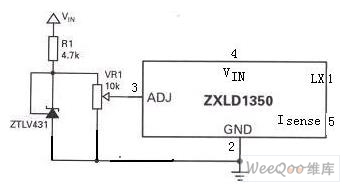
The ZXLD1350 driver is a continuous inductive buck converter with multiple switches and an output current of 350mA with an input voltage range of 7V to 30V. Its feature is that the ZXLDl350 is equipped with a multi-function adjustment foot that adjusts the brightness of the LED in a variety of ways by controlling the current of the LED.
Figure 1 DC voltage dimming diagram
The TLV431 acts as a shunt regulator to generate an external 1.25V voltage reference. This voltage reference is applied to the VRl potential to provide a dimming voltage of 0V-1.25V. Using an external regulator will affect the accuracy of the current setting. The 1% voltage reference is used to make the LED current more accurate than the built-in voltage reference.
The adjustment pin can be overdriven with an external DC voltage (VADJ) to achieve a built-in voltage reference and adjust the output current to exceed or fall below the rated value. The rated output current at this time is:

Note that the 100% brightness setting corresponds to VADJ=VREF. If VIN reaches a maximum of 2.5V, RSENSE should be doubled. This will reduce the power by a small 1% to 2%. The input impedance of the adjustment pin is 200kV+20%. If the output impedance of the DC voltage is relatively high, it may have an effect.
2.2 New dimming technology--Application of PWM modulation technology
The wavelength at which the LED emits light is closely related to the forward current driven in the device. In order to prevent color tone changes, the dimming method must be carefully selected. The most common dimming method used in the past was to change the forward current or voltage on the device. Unfortunately, changes in current or voltage change the wavelength of the light. This effect is proportional to the wavelength, and the longer wavelengths experience the strongest change in current versus current. In many applications, this result is unacceptable. If PWM modulation is used, the LED can be properly dimmed without causing wavelength changes. The on-off operation of the LED is achieved by changing the duty cycle, where the forward current (1F) is a constant current.
2.2.1 Low frequency high frequency dimming application
(1) Low frequency dimming. Since the LED has a stable instantaneous driving current, it is suitable for low-frequency withering. The color temperature of the LED remains the same at all brightness levels. Another advantage of low frequency dimming is that the brightness can be reduced to 1%. Therefore the dimming range is 100:1. The frequency selection is to avoid visible flicker, and the PWM signal must be greater than 100 Hz. If the selected frequency is too high, the built-in low-pass filter will begin to combine the PWM signals and produce a nonlinear response. Simultaneous adjustment of the soft start function of the needle will cause a delay in the rise or fall of the PWM signal. This will give the LED current a non-linear characteristic that is more pronounced as the frequency increases.
A schematic diagram of pulse width modulation of common low frequency and high frequency signals is shown in FIG. 2 . This figure is a schematic diagram of pulse width modulation using the ZETEX ZXLD1350 driver as an example.
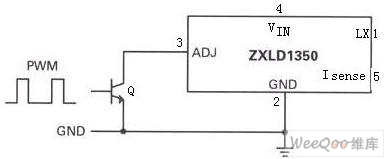
Figure 2 Schematic diagram of pulse width modulation using the ZXLD1350 driver as an example
The upper limit of the low frequency is recommended to be 1 kHz. The effects of noise that may be audible to the inductor also need to be considered. This may occur with some loosely wound inductors, which will be more pronounced than 100 Hz at a PWM frequency of 1 kHz.
(2) High frequency dimming
If the system requires low radiation and input/output harmonics, high frequency dimming is suitable. But the dimming range will drop to 5:l. The ZXLDl350 features a built-in low-pass filter that integrates high-frequency PWM signals for DC dimming control. If the PWM frequency is above 10 kHz and the duty cycle is greater than the specified minimum, the device will remain active and the output will remain unchanged.
(3) Input buffer transistor
For PWM dimming, the input bipolar transistor Q should use an open collector output (as shown in Figure 2). To ensure that the input shutdown threshold of 200mV is reached. PWM control can also be performed directly without using a buffer transistor, but care must be taken. This operation will overload the built-in 1.25V voltage reference. If 100% PWM (DC) uses a 2.5V input voltage, the output current into the LED will reach twice the normal current. And may damage the ZXLDl350. Overdriving with a 5V logic signal will most likely damage the unit beyond the rated voltage of the adjustment pin.
(4) Soft start and decoupling capacitors
Any additional capacitors on the adjustment pin will affect the PWM signal rise and fall. Since the rise time will increase by about 0.5ms/nF, this needs to be considered. Compare it with 100Hz PWM, turn on time Ton at 50% duty cycle, and off time Toff at 5ms, and turn on time Ton at 0.1% at 1% duty cycle. Adjusting the lnF on the pin will result in a rise time of 0.5ms, which will cause errors and limitations when dimming at low duty cycles.
2.2.2 Accurately control brightness with linear and PWM input signals
The program is based on highly integrated technology. It features high efficiency and low power consumption, and requires minimal external components and accurate temperature/brightness control. The new LM3402/02HV switching regulator can meet the needs of this technology. Figure 3 shows the application of the LM3402/02HV switching regulator.
The LM3402/02HV switching regulator in Figure 3 features dedicated brightness control (DIM) pins that accurately control brightness with linear and PWM input signals. Lighting systems that use LEDs to illuminate generally use PWM light and dark control to control the brightness of the light. This brightness control method has become the standard commonly used in the industry. As long as the current of the forward LED is adjusted, the light output of the LED will increase or decrease in a linear manner, but the wavelength of most of the light will shift. Some applications do not require strict color requirements, so linear brightness control is still used, but automotive lights such as brake lights, LCD backlights, and direct-display RGB LEDs have extremely strict requirements on brightness and color. This type of application generally uses PWM to control brightness.

Figure 3 Schematic diagram of the application of the LM3402/02HV switching regulator
The LM3402/02HV switching regulator features the following: input voltage range 6V ~ 75V, using the buck regulator line layout; can provide a constant drive current for the LED, feedback voltage is 200mV; when the RON pin is low When the shutdown current is further reduced; accurate PWM brightness control; switching frequency up to 1MHz; with hysteresis function, and the on-time is fixed. Therefore, switching frequency (FSW) control can be performed over the entire input voltage range.
2.2.3 Application of a PWM controlled series switch
When the PWM frequency is higher than 100 Hz, the human eye cannot perceive a single pulse. However, integrating these pulses to understand them is brightness, and by linearly changing the duty ratio, the brightness can be linearly changed without any wavelength change. As shown in Figure 4, the most common method of adjusting LED brightness is a PWM controlled series switch. Because the forward operating current is relatively high, care must be taken when selecting the switch to ensure that the switch can handle conduction losses.
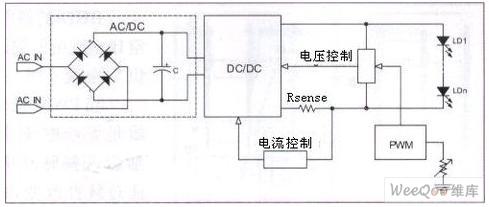
Figure 4 Block diagram of PWM dimming technology that references ST's new technology
To overcome this problem, this solution eliminates the series switch and also improves energy efficiency. Figure 4 shows a block diagram of the new dimming technology, citing the new technology from ST. This new technology exists in two control loops: a current loop and a voltage loop (shown in Figure 4). When maximum brightness is required, the current is driven in the same direction with a steady forward current; during the dimming operation, the current control loop will limit the maximum output current while the voltage loop will maintain the output voltage below the sum of the LED array threshold voltages. . When the LED is turned off, the voltage loop will control the maximum output voltage. The block diagram of the new dimming technology results in a cheaper and more efficient solution because the power switch is no longer used.
3. Adding the application of intelligent brightness control technology
LED lighting applications can benefit from the intelligence of the MCU. The MCU can be used for a variety of tasks, including user interface, communication, battery status monitoring, and temperature measurement. Adding an MCU to a design does not mean increasing complexity, taking up space, or more expensive. For example, Microchip offers the PIC10F family of MCUs in a 6-pin SOT-23 package. There are also oscillators and reset circuits inside the device. Connect the power supply and ground to get 4 I/O pins that can be programmed to perform any desired task. The FPIC10F pin can be used as an analog or digital pin. Two device models in the FPIC10F family include analog comparator modules. Two FPIC10FP device models include an 8-bit analog-to-digital converter (ADC). You only need to learn 33 assembly instructions to write code for the PIPICOF.
One application of MCUs in LED lighting is brightness control. Power LEDs can be dimmed by reducing the drive current. However, this is not the most efficient way to control LED brightness. Power LEDs achieve optimum efficiency at the highest rated drive current. Better efficiency can be achieved by switching the LEDs using low frequency PWM signals. The PWM signal is connected to the enable input of the SMPS control IC. When turned on, the LED is always driven at the highest current.
The PICl0F206 device provides a user button interface to the SMPS IC and generates a PWM control signal. The PIC10F206 has an internal oscillator and reset circuitry and does not require any external circuitry. In these applications, the PIC10F206 device can also be used to linearize brightness control or monitor battery status.
3.1 How to generate PWM control signals in the new solution
There are several ways to generate a PWM control signal to control the power supply circuit. A device with a capture-compare-PWM(*) module can use the on-chip digital time base to generate a PWM signal to control the power supply circuit. The output from the buck LED driver using the PIC12HV615 comparator shown in Figure 5 can be output to Q1. see.
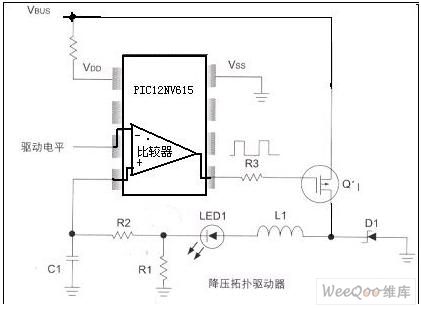
Figure 5 Buck LED Driver Using PIC12HV615 Comparator
The signal pulse width is controlled by the MCU clock and duty cycle registers; the enhanced *(E*) module allows one PWM signal to control 2 or 4 output pins for half-bridge or H-bridge control; with comparator and E* The module's device can use the comparator signal to control the turn-off time of the PWM signal; devices with comparators and PWM SR latches can use the comparator signal and/or clock pulse to switch the latch output; external PWM peripherals can be used IC. This method is useful when multiple high speed PWM channels are required. The PWM signal can be generated using software and I/O pins. The PWM frequency and duty cycle resolution requirements are not too high, and the cost of this method is lower; PIC microcontrollers with on-chip comparators (such as the PICl2F609) can be used to implement simple LED drivers. The PICl2HV609 adds an internal voltage regulator that operates from a DC bus above 5V.
3.2 PWM Control Signal Generation Example--MCPl630 High Speed ​​PWM Controller
The MCPl630 provides another method for generating high speed PWM signals for high power LED drivers (see Figure 6).
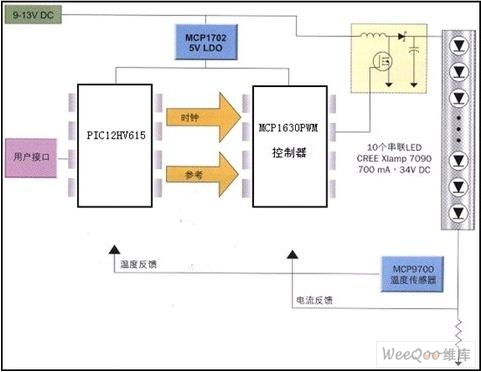
Figure 6 High-power LED driver provided by MCPl630
The MCPl630 is an 8-pin device that contains the components needed to generate an analog PWM control loop, including: error amplifiers, comparators, and high current output pins that drive power transistors. The MCPl630 is intended for use with MCUs that provide a reference clock source. The PICHV615MCU controls the PWM frequency and maximum duty cycle. Switching frequencies up to 1MHz, depending on the application. The MCU can also control the reference input of the error amplifier when dimming or soft-start is required. Multiple MCPl630 devices can be connected to one MCU to support multiple supply channels.
The MCPl630 can be used to solve advanced power supply challenges. When using multiple MCPl630 devices, a phase offset can be applied to each clock input to reduce bus current ripple. For EMI-sensitive applications, jitter can be applied to the clock signal to reduce the radiant energy at a given frequency.
4. Application of strengthening backlight control brightness control technology
The brightness control of the backlight LED can be achieved via PWM or constant current control. PWM brightness control requires a constant current driver to drive the LED, but the on/off time needs to be adjusted to achieve the desired luminosity. Therefore, PWM is more complicated than direct constant current control. Then a new solution was presented. To this end, RGB LED backlighting is taken as an example for illustration.
The pixels in the LCD display are divided into three main color zones: red, green, and blue. The pixel color is defined by the mixture of the three main colors. With the RGB backlight, when the LED temperature changes, the driver must correct the brightness balance between the three main colors of red, green and blue to prevent white point shift. In addition, the driver must ensure that the correct intensity of the light is maintained at any operating temperature, and in terms of compensation, it can be in closed or open loop form. For closed-loop compensation, a photoreceptor is required to measure the white point and its intensity. Conversely, if open-loop compensation is used, the temperature needs to be measured beforehand and the brightness balance is adjusted by a predefined compensation curve. An example of an RGB backlight driver such as the LP5520 is an open-loop compensated LED driver. Figure 7 shows the principle of open loop color compensation.

Figure 7 Principle of open loop color compensation
The temperature compensation curve is measured by RGB LEDs in real-world applications, which are programmed into the EEPROM memory inside the chip. The chip is integrated into the LCD display module, and the module manufacturer will program the compensation curve during production. In addition, RGB LED backlights can also be used as optimized color filters.
5 Conclusion
The above-mentioned efficient LED brightness control technology has several different topologies, which are summarized into two categories: one is to use an analog driver IC independently, or to use it with an MCU (to add intelligence); the second is to The LED driver function is integrated into the MCU application. The choice of topology depends on the application, and the upcoming integrated multi-tasking mixed-signal solution will bring new challenges to LED brightness control technology.
:
Rechargeable Blenders are our new product series. With 12V, 160W, two 2000Ah battery, USB plug, charge time just 3 hours while can use 12 to 15 times. Our Rechargeable Blenders have stainless steel body, 450ml heat resisted glass bottle and 6pcs ice crushing blades. What's more, our rechargeable blenders with safety lock system.
Discription of Rechargeable Blenders
Size: 450ml
Jar Material: Heat resisted borosilicate glass bottle
Plug Type: USB
Working Time: 40s working time and 6s auto stop in empty loading
Rechargeable Blenders
Rechargeable Blenders,Usb Rechargeable Blender,Rechargeable Hand Blender,Cordless Rechargeable Hand Blender
Flying Electronic Co., Ltd , http://www.flyingelectronic.com
